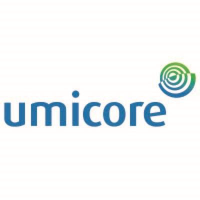Company Analysis Umicore SA
1. Summary
Advantages
- Price (3.35 $) is less than fair price (3.96 $)
- Dividends (6.57%) are higher than the sector average (4.88%).
- The stock's return over the last year (4.1%) is higher than the sector average (-1.27%).
Disadvantages
- Current debt level 31.44% has increased over 5 years from 23.84%.
- The company's current efficiency (ROE=-48.81%) is lower than the sector average (ROE=20.84%)
Similar companies
2. Share price and performance
2.1. Share price
2.3. Market efficiency
| Umicore SA | Industrials | Index | |
|---|---|---|---|
| 7 days | 16.8% | -7.9% | -0.1% |
| 90 days | 63% | 1.7% | 6.8% |
| 1 year | 4.1% | -1.3% | 10.9% |
UMICY vs Sector: Umicore SA has outperformed the "Industrials" sector by 5.37% over the past year.
UMICY vs Market: Umicore SA has significantly underperformed the market by -6.8% over the past year.
Stable price: UMICY is not significantly more volatile than the rest of the market on "OTC" over the last 3 months, with typical variations of +/- 5% per week.
Long period: UMICY with weekly volatility of 0.0788% over the past year.
3. Summary of the report
4. Fundamental Analysis
4.1. Stock price and price forecast
Below fair price: The current price (3.35 $) is lower than the fair price (3.96 $).
Price not significantly lower than the fair price: The current price (3.35 $) is slightly lower than the fair price by 18.2%.
4.2. P/E
P/E vs Sector: The company's P/E (3.83) is lower than that of the sector as a whole (36.8).
P/E vs Market: The company's P/E (3.83) is lower than that of the market as a whole (59.91).
4.2.1 P/E Similar companies
4.3. P/BV
P/BV vs Sector: The company's P/BV (1.25) is lower than that of the sector as a whole (3.76).
P/BV vs Market: The company's P/BV (1.25) is lower than that of the market as a whole (3.41).
4.3.1 P/BV Similar companies
4.4. P/S
P/S vs Sector: The company's P/S indicator (0.1689) is lower than that of the sector as a whole (2.52).
P/S vs Market: The company's P/S indicator (0.1689) is lower than that of the market as a whole (3.65).
4.4.1 P/S Similar companies
4.5. EV/Ebitda
EV/Ebitda vs Sector: The company's EV/Ebitda (0.9569) is lower than that of the sector as a whole (13.55).
EV/Ebitda vs Market: The company's EV/Ebitda (0.9569) is lower than that of the market as a whole (40.07).
5. Profitability
5.1. Profitability and revenue
5.2. Earnings per share - EPS
5.3. Past profitability Net Income
Yield Trend: Negative and has fallen by -219.19% over the last 5 years.
Accelerating profitability: The return for the last year (0%) exceeds the average return for 5 years (-219.19%).
Profitability vs Sector: The return for the last year (0%) exceeds the return for the sector (-11.44%).
5.4. ROE
ROE vs Sector: The company's ROE (-48.81%) is lower than that of the sector as a whole (20.84%).
ROE vs Market: The company's ROE (-48.81%) is lower than that of the market as a whole (41.13%).
5.5. ROA
ROA vs Sector: The company's ROA (-14.22%) is lower than that of the sector as a whole (8.81%).
ROA vs Market: The company's ROA (-14.22%) is lower than that of the market as a whole (29.37%).
5.6. ROIC
ROIC vs Sector: The company's ROIC (12.86%) is higher than that of the sector as a whole (10.31%).
ROIC vs Market: The company's ROIC (12.86%) is higher than that of the market as a whole (11.01%).
7. Dividends
7.1. Dividend yield vs Market
High yield: The dividend yield of the company 6.57% is higher than the average for the sector '4.88%.
7.2. Stability and increase in payments
Dividend stability: The company's dividend yield 6.57% has been steadily paid over the past 7 years, DSI=0.79.
Weak dividend growth: The company's dividend yield 6.57% has been growing weakly or stagnant over the past 5 years. Growth over only 0 years.
7.3. Payout percentage
Dividend Coverage: Current payments from income (49.94%) are at a comfortable level.
Pay for your subscription
More functionality and data for company and portfolio analysis is available by subscription


